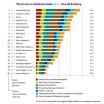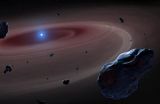(Press-News.org) Quasars are the intensely luminous centres of distant galaxies that are powered by huge black holes. This new study has looked at one of these energetic objects – known as SDSS J1106+1939 – in great detail, using the X-shooter instrument on ESO's VLT at the Paranal Observatory in Chile [1]. Although black holes are noted for pulling material in, most quasars also accelerate some of the material around them and eject it at high speed.
"We have discovered the most energetic quasar outflow known to date. The rate that energy is carried away by this huge mass of material ejected at high speed from SDSS J1106+1939 is at least equivalent to two million million times the power output of the Sun. This is about 100 times higher than the total power output of the Milky Way galaxy – it's a real monster of an outflow," says team leader Nahum Arav (Virginia Tech, USA). "This is the first time that a quasar outflow has been measured to have the sort of very high energies that are predicted by theory."
Many theoretical simulations suggest that the impact of these outflows on the galaxies around them may resolve several enigmas in modern cosmology, including how the mass of a galaxy is linked to its central black hole mass, and why there are so few large galaxies in the Universe. However, whether or not quasars were capable of producing outflows powerful enough to produce these phenomena has remained unclear until now [2].
The newly discovered outflow lies about a thousand light-years away from the supermassive black hole at the heart of the quasar SDSS J1106+1939. This outflow is at least five times more powerful than the previous record holder [3]. The team's analysis shows that a mass of approximately 400 times that of the Sun is streaming away from this quasar per year, moving at a speed of 8000 kilometres per second.
"We couldn't have got the high-quality data to make this discovery without the VLT's X-shooter spectrograph," says Benoit Borguet (Virginia Tech, USA), lead author of the new paper. "We were able to explore the region around the quasar in great detail for the first time."
As well as SDSS J1106+1939, the team also observed one other quasar and found that both of these objects have powerful outflows. As these are typical examples of a common, but previously little studied, type of quasars [4], these results should be widely applicable to luminous quasars across the Universe. Borguet and colleagues are currently exploring a dozen more similar quasars to see if this is the case.
"I've been looking for something like this for a decade," says Nahum Arav, "so it's thrilling to finally find one of the monster outflows that have been predicted!"
INFORMATION:
Notes
[1] The team observed SDSS J1106+1939 and J1512+1119 in April 2011 and March 2012 using the X-shooter spectrograph instrument attached to ESO's VLT. By splitting the light up into its component colours and studying in detail the resultant spectrum the astronomers could deduce the velocity and other properties of the material close to the quasar.
[2] The powerful outflow observed in SDSS J1106+1939 carries enough kinetic energy to play a major role in active galaxy feedback processes, which typically require a mechanical power input of roughly 5% of the luminosity of the quasar. The rate at which kinetic energy is being transferred by the outflow is described as its kinetic luminosity.
[3] SDSS J1106+1939 has an outflow with a kinetic luminosity of at least 1046 ergs s−1. The distances of the outflows from the central quasar (300–8000 light-years) was greater than expected suggesting that we observe the outflows far from the region in which we assume them to initially accelerated (0.03–0.4 light-years).
[4] A class known as Broad Absorption Line (BAL) quasars.
More information
This research was presented in a paper, "Major contributor to AGN feedback: VLT X-shooter observations of SIV BAL QSO outflows", to appear in The Astrophysical Journal.
The team is composed of B. C. J. Borguet (Virginia Tech, USA), N. Arav (Virginia Tech, USA), D. Edmonds (Virginia Tech, USA), C. Chamberlain (Virginia Tech, USA), C. Benn (Isaac Newton Group of Telescopes, Spain).
The year 2012 marks the 50th anniversary of the founding of the European Southern Observatory (ESO). ESO is the foremost intergovernmental astronomy organisation in Europe and the world's most productive ground-based astronomical observatory by far. It is supported by 15 countries: Austria, Belgium, Brazil, the Czech Republic, Denmark, France, Finland, Germany, Italy, the Netherlands, Portugal, Spain, Sweden, Switzerland and the United Kingdom. ESO carries out an ambitious programme focused on the design, construction and operation of powerful ground-based observing facilities enabling astronomers to make important scientific discoveries. ESO also plays a leading role in promoting and organising cooperation in astronomical research. ESO operates three unique world-class observing sites in Chile: La Silla, Paranal and Chajnantor. At Paranal, ESO operates the Very Large Telescope, the world's most advanced visible-light astronomical observatory and two survey telescopes. VISTA works in the infrared and is the world's largest survey telescope and the VLT Survey Telescope is the largest telescope designed to exclusively survey the skies in visible light. ESO is the European partner of a revolutionary astronomical telescope ALMA, the largest astronomical project in existence. ESO is currently planning the 39-metre European Extremely Large optical/near-infrared Telescope, the E-ELT, which will become "the world's biggest eye on the sky".
Links
Research paper: http://www.eso.org/public/archives/releases/sciencepapers/eso1247/eso1247a.pdf
Photos of the VLT: http://www.eso.org/public/images/archive/category/paranal/
Contacts
Nahum Arav
Virginia Tech
Blacksburg, VA, USA
Tel: 540-231-8736
Email: arav@vt.edu
Benoît Borguet
Virginia Tech
Blacksburg, VA, USA
Email: b.borguet@alumni.ulg.ac.be
Richard Hook
ESO, La Silla, Paranal, E-ELT & Survey Telescopes Press Officer
Garching bei München, Germany
Tel: 49-89-3200-6655
Cell: 49-151-1537-3591
Email: rhook@eso.org
Biggest black hole blast discovered
New European Southern Observatory observations reveal most powerful quasar outflow ever found
2012-11-28
ELSE PRESS RELEASES FROM THIS DATE:
Potentially toxic flame retardants found in many US couches
2012-11-28
DURHAM, N.C. -- More than half of all couches tested in a Duke University-led study contained potentially toxic or untested chemical flame retardants that may pose risks to human health.
Among the chemicals detected was "Tris," a chlorinated flame retardant that is considered a probable human carcinogen based on animal studies.
"Tris was phased out from use in baby pajamas back in 1977 because of its health risks, but it still showed up in 41 percent of the couch foam samples we tested," said Heather Stapleton, associate professor of environmental chemistry at ...
80 percent of parents interested in genetic risk assessment for siblings of children with autism
2012-11-28
Cambridge, MA (November 28, 2012)--The vast majority (80 percent) of parents with at least one child with Autism Spectrum Disorder (ASD) would pursue genetic testing if a test were available that could identify risk in a younger sibling, citing the desire for earlier identification of children at risk, earlier evaluation and intervention, closer monitoring and lessened anxiety. The findings were reported in "Parental Interest in a Genetic Risk Assessment Test for Autism Spectrum Disorders," a survey published online today in the journal Clinical Pediatrics.
The survey ...
WSU researchers use 3-D printer to make parts from moon rock
2012-11-28
PULLMAN, Wash. - Imagine landing on the moon or Mars, putting rocks through a 3-D printer and making something useful – like a needed wrench or replacement part.
"It sounds like science fiction, but now it's really possible," says Amit Bandyopadhyay, professor in the School of Mechanical and Materials Engineering at Washington State University.
Bandyopadhyay and a group of colleagues recently published a paper in Rapid Prototyping Journal demonstrating how to print parts using materials from the moon.
Bandyopadhyay and Susmita Bose, professor in the School of Mechanical ...
Treating cocaine dependence: A promising new pharmacotherapy
2012-11-28
Philadelphia, PA, November 28, 2012 – Medication development efforts for cocaine dependence have yet to result in an FDA approved treatment. The powerful rewarding effects of cocaine, the profound disruptive impact of cocaine dependence on one's lifestyle, and the tendency of cocaine to attract people who make poor life choices and then exacerbate impulsive behavior all make cocaine a vexing clinical condition.
In this battle, many candidate pharmacotherapies have been tested, but none have succeeded sufficiently to be adopted widely. Perhaps like cancer, heart disease, ...
Brain cell transplants in early 2013
2012-11-28
As part of the European study TRANSEURO, five patients with Parkinson's disease will undergo brain cell transplants at Skåne University Hospital in Lund, Sweden, in early 2013. These are the first operations of their kind in Europe for over 10 years.
The TRANSEURO study, which in Sweden is led by Lund University, is now taking a critical approach to the viability of cell therapy as a future treatment for Parkinson's disease. Can we replace cells that die as a result of our most common neurological diseases? What are the therapies of the future for neurodegenerative diseases ...
Report finds Big Pharma is doing more for access to medicine in developing countries
2012-11-28
Amsterdam, the Netherlands: The latest Access to Medicine Index, which ranks the top 20 pharmaceutical companies on their efforts to improve access to medicine in developing countries, finds that the industry is doing more than it was two years ago, with GlaxoSmithKline still outperforming its peers, but an expanding group of leaders closing the gap.
The Index, published Wednesday, found that Johnson & Johnson was one of the most dramatic risers, climbing from the middle of the field in 9th position in the 2010 Index to 2nd this year, closely behind GlaxoSmithKline. It ...
Anthropological expertise facilitates multicultural women's health care
2012-11-28
Collaboration between medical and anthropological expertise can solve complex clinical problems in today's multicultural women's healthcare, shows Pauline Binder, a medical anthropologist, who will present her thesis on 1 December at the Faculty of Medicine, Uppsala University, Sweden.
Pauline Binder has applied in-depth medical anthropological research approaches to understand clinical problems in ways not possible using only statistics. Why pregnant Somali women have an increased risk of complications even after migration has been the starting point for her fieldwork. ...
Researchers identify ways to exploit 'cloud browsers' for large-scale, anonymous computing
2012-11-28
Researchers from North Carolina State University and the University of Oregon have found a way to exploit cloud-based Web browsers, using them to perform large-scale computing tasks anonymously. The finding has potential ramifications for the security of "cloud browser" services.
At issue are cloud browsers, which create a Web interface in the cloud so that computing is done there rather than on a user's machine. This is particularly useful for mobile devices, such as smartphones, which have limited computing power.The cloud-computing paradigm pools the computational ...
Graphite experiment shines new light on giant planets, white dwarfs and laser-driven fusion
2012-11-28
An international team led by researchers from the University of Warwick and Oxford University is now dealing with unexpected results of an experiment with strongly heated graphite (up to 17,000 degrees Kelvin). The findings may pose a new problem for physicists working in laser-driven nuclear fusion and may also lead astrophysicists to revise our understanding of the life cycle of giant planets and stars.
The researchers were attempting to get a better understanding about how energy is shared between the different species of matter, especially, how it is transferred from ...
Family's economic situation influences brain function in children
2012-11-28
Children of low socioeconomic status work harder to filter out irrelevant environmental information than those from a high-income background because of learned differences in what they pay attention to, according to new research published in the open access journal Frontiers in Human Neuroscience.
Numerous studies in the past few years have begun to reveal how poverty affects brain development and function. In 2008, Amedeo D'Angiulli of Carleton University in Ottawa, Canada and his colleagues used electroencephalography (EEG) to measure the brain wave patterns associated ...
LAST 30 PRESS RELEASES:
New software sheds light on cancer’s hidden genetic networks
UT Health San Antonio awarded $3 million in CPRIT grants to bolster cancer research and prevention efforts in South Texas
Third symposium spotlights global challenge of new contaminants in China’s fight against pollution
From straw to soil harmony: International team reveals how biochar supercharges carbon-smart farming
Myeloma: How AI is redrawing the map of cancer care
Manhattan E. Charurat, Ph.D., MHS invested as the Homer and Martha Gudelsky Distinguished Professor in Medicine at the University of Maryland School of Medicine
Insilico Medicine’s Pharma.AI Q4 Winter Launch Recap: Revolutionizing drug discovery with cutting-edge AI innovations, accelerating the path to pharmaceutical superintelligence
Nanoplastics have diet-dependent impacts on digestive system health
Brain neuron death occurs throughout life and increases with age, a natural human protein drug may halt neuron death in Alzheimer’s disease
SPIE and CLP announce the recipients of the 2025 Advanced Photonics Young Innovator Award
Lessons from the Caldor Fire’s Christmas Valley ‘Miracle’
Ant societies rose by trading individual protection for collective power
Research reveals how ancient viral DNA shapes early embryonic development
A molecular gatekeeper that controls protein synthesis
New ‘cloaking device’ concept to shield sensitive tech from magnetic fields
Researchers show impact of mountain building and climate change on alpine biodiversity
Study models the transition from Neanderthals to modern humans in Europe
University of Phoenix College of Doctoral Studies releases white paper on AI-driven skilling to reduce burnout and restore worker autonomy
AIs fail at the game of visual “telephone”
The levers for a sustainable food system
Potential changes in US homelessness by ending federal support for housing first programs
Vulnerability of large language models to prompt injection when providing medical advice
Researchers develop new system for high-energy-density, long-life, multi-electron transfer bromine-based flow batteries
Ending federal support for housing first programs could increase U.S. homelessness by 5% in one year, new JAMA study finds
New research uncovers molecular ‘safety switch’ shielding cancers from immune attack
Bacteria resisting viral infection can still sink carbon to ocean floor
Younger biological age may increase depression risk in older women during COVID-19
Bharat Innovates 2026 National Basecamp Showcases India’s Most Promising Deep-Tech Ventures
Here’s what determines whether your income level rises or falls
SCIE indexation achievement: Celebrate with Space: Science & Technology
[Press-News.org] Biggest black hole blast discoveredNew European Southern Observatory observations reveal most powerful quasar outflow ever found



